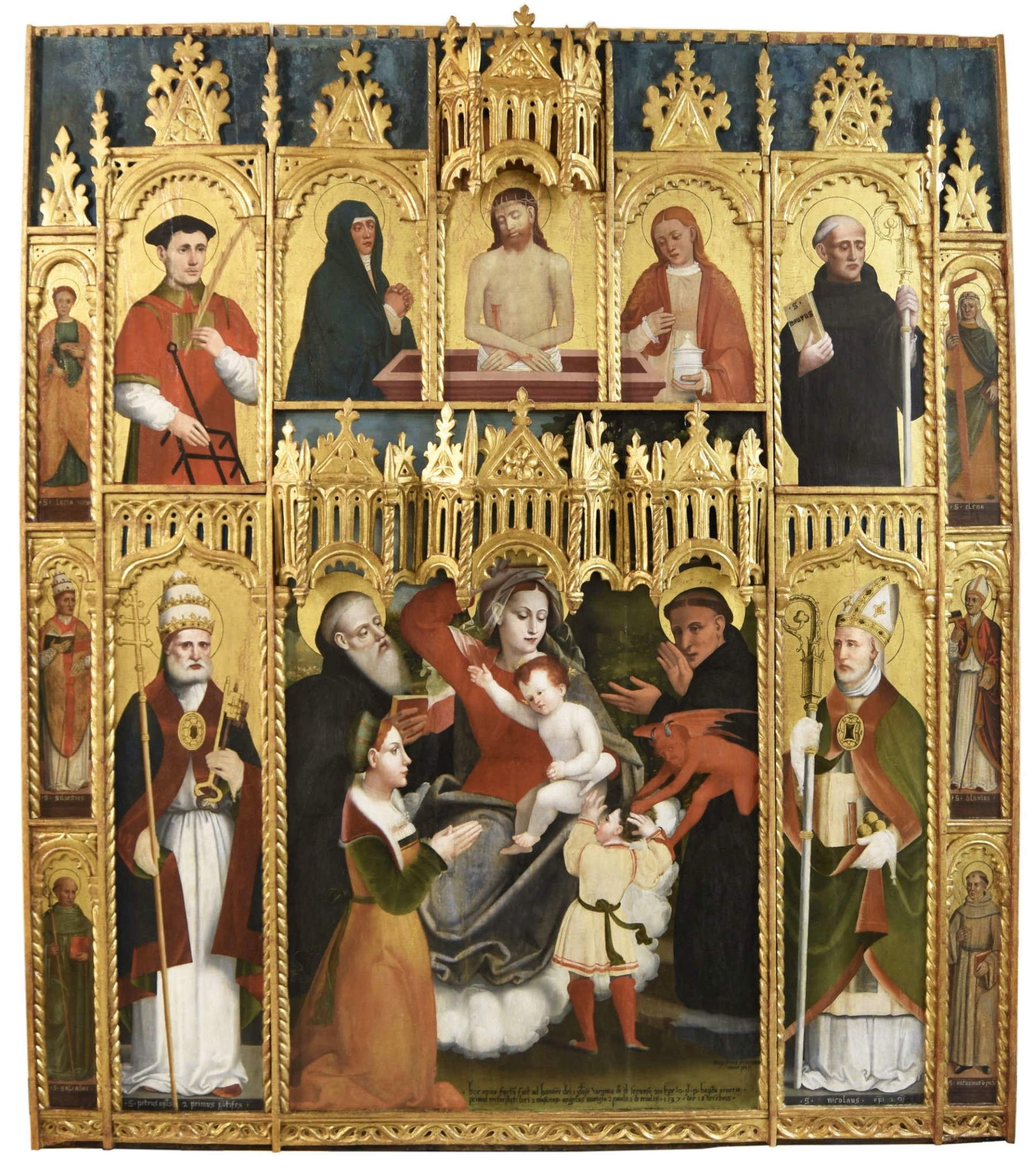In Albenga, restoration of Agostino da Casanova's polyptych ends
In Liguria , the restoration of the Polyptych of the “Madonna del Soccorso,” a masterpiece dated 1537 and signed by Agostino da Casanova, a sixteenth-century Ligurian painter active on the Riviera di Ponente, ends. For the occasion, the work, presented on Saturday, December 21 at 3:30 p.m. at the Auditorium of the Redemptoris Mater School Pole in Albenga, will be exceptionally exhibited in the rooms of the Diocesan Museum of Albenga, where visitors will be able to admire it as part of the Formae Lucis exhibition before its definitive return to the church of Santissima Annunziata in Tavole (hamlet of Prelà, province of Imperia), scheduled for spring 2025.
The Polyptych was in a precarious conservation condition that required urgent intervention. Thanks to funds made available by the Ministry of Culture, the Soprintendenza Archeologia, Belle Arti e Paesaggio for the provinces of Imperia and Savona promoted and coordinated a complex restoration, carried out by restorer Riccardo Bonifacio.

The restoration
The work had undergone a drastic intervention in the past: in 1953 the original crossbeams of the wooden structure had been removed and replaced with movable parquetry. These interventions had altered the integrity of the frame and compromised the pictorial part, on which repainting and plastering had been done that hid the original color.
“A drastic intervention carried out in 1953,” says Riccardo Bonifacio, “had involved the removal of the original crossbeams, which were replaced at the time with a mobile parquetry that needed, at this stage, careful revision. The pictorial part had seen important repainting and plastering that covered areas of original color: we removed these interventions without further attacking the original chromatics, consolidating and reviving a work of great quality and unique also from an iconographic point of view.”
During the restoration, significant novelties emerged: “The restoration also made it possible to reveal some hitherto unknown details related both to the technique employed by the painter and to the executive phases of the work’s realization,” emphasizes Martina Avogadro, Restoration Officer of the Superintendence and director of the work.
The Polyptych of Our Lady of Succor represents a high point in the artistic production of Agostino da Casanova, one of the most interesting and enigmatic painters among those active in Western Liguria in the 16th century, as pointed out by Francesca De Cupis, Art Historian Functionary of the Superintendency. “The Tavole polyptych,” De Cupis explains, “admirably synthesizes the eclectic language of the artist, who knew how to rework in a very personal style the many different cultural components and suggestions - Nordic, Piedmontese, Provençal - on which his own figurative culture was nourished.”
The event, in addition to celebrating the restoration, is a tribute to the memory of art historian Massimo Bartoletti, who died prematurely, whose research work on 16th-century painting in western Liguria helped shed light on the activity of Agostino da Casanova. The figure of the painter and the Polittico di Tavole find ample space in the volume Officine pittoriche del ’500 nel Ponente Ligure, edited by Franco Boggero, which collects unpublished studies by Bartoletti.
A heritage restored
“This restoration,” emphasizes Superintendent Federico Barello, “is a tangible manifestation of the work carried out by our Institute on cultural heritage, even when not state-owned, with particular attention to all the realities of the territory, including those in smaller towns, far from the most frequented circuits and for this reason even more deserving of our attention.”
After the presentation, participants will be able to move to the Diocesan Museum in Albenga to admire the restored work. As Don Mauro Marchiano, director of the Museum, explains, “it will be a unique opportunity to be able to observe the work at close range, before its planned return in the spring of 2025 to the Church of the SS. Annunziata, when the work will be returned to the community of Tavole.”
The event represents a double value, as pointed out by Castore Sirimarco, director of the Cultural Heritage Office of the Diocese of Albenga-Imperia: the double value is “that of the work, which we can admire today in its restored form, but also the value that brings us back to Massimo Bartoletti.” With its return to the Tavole community in the spring of 2025, the Madonna del Soccorso Polyptych will return to its original context, renewing the link between art, history, and territory.
 |
| In Albenga, restoration of Agostino da Casanova's polyptych ends |
Warning: the translation into English of the original Italian article was created using automatic tools. We undertake to review all articles, but we do not guarantee the total absence of inaccuracies in the translation due to the program. You can find the original by clicking on the ITA button. If you find any mistake,please contact us.





























